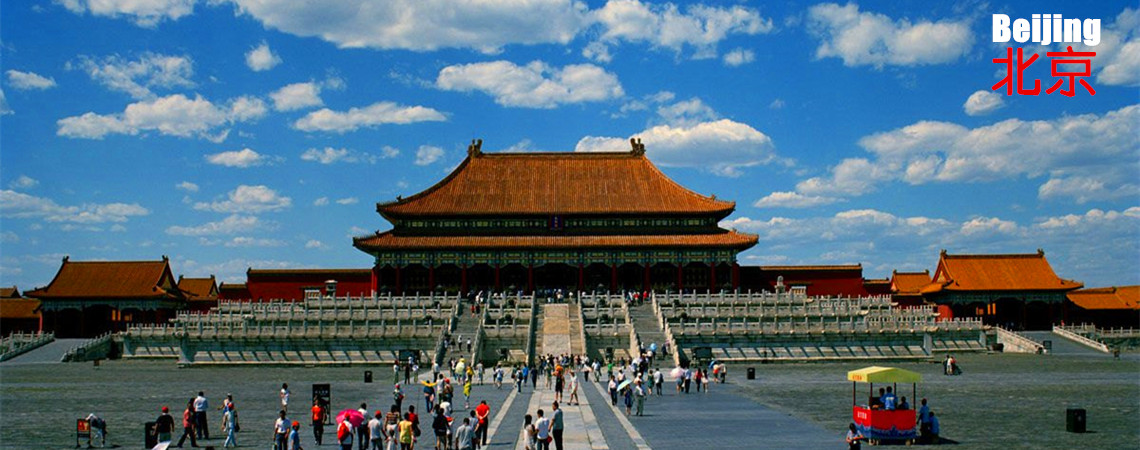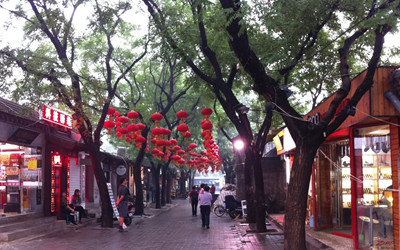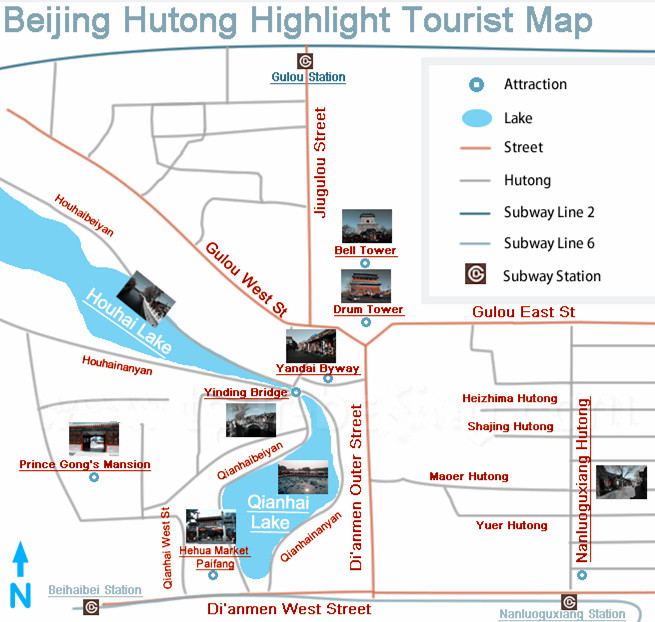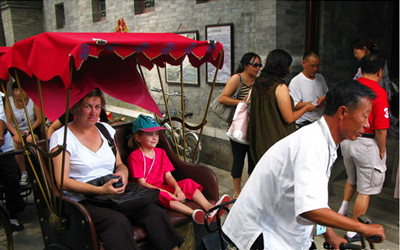
Beijing Hutong
 Hutong is in fact, alley or lane, a typical building with local architectural style in northern China, particularly in Beijing. It originally dated from Yuan dynasty (1271-1368). Generally, it is expressed to be flat and small houses. Most of northern culture is originated from Hutong.
Hutong is in fact, alley or lane, a typical building with local architectural style in northern China, particularly in Beijing. It originally dated from Yuan dynasty (1271-1368). Generally, it is expressed to be flat and small houses. Most of northern culture is originated from Hutong.
Hutong,whose pronunciation is directly from Mongolian, has an over 700-year history, up to the present. Hence, Hutong in Beijing is the product of the time-honored history. It reflects the real appearance of Beijing's history.
Hutongs in Beijing
Majority of Hutong in Beijing is built following the east and west directions, or south and north directions. Therefore, it forms the square structure of Beijing and shows the establishment of Beijing is delicately programmed according to the sturcture of chessboard.
 Shichahai Hutong
Shichahai Hutong
It's the top choice among varieties of Hutong. The well-preserved houses could take you back to the common life of the old Beijing. Along the street, you can see the local's daily activities. The tranquility is the first characteristic of Hutong. Living or staying there, you could be far away from anxiety, tiredness, uneasiness, as well as other unhealthy social reactions.
Dongjiaominxiang Hutong
It is famous for its history. In 1900,the Boxers Rebellion was broken out to fight against western influence. European and US legations in Beijing were besieged and many missionaries and Europeans were killed. An international punitive force was dispatched and Beijing was captured on 14 August 1900. In September 1901 China agreed to pay reparations.
Bada Hutong
Badahutong, located at the west side of Kwan-yin Temple of Qianmenwai. Bada (literally means Eight Large, but it doesn’t mean eight but mean many). Bada Hutong used to be the center of the oldest profession or some folk performances of Beijing. Publicly-accepted eight Hutongs were Baishu Hutong, Yanzhi Hutong, Hanjia Hutong, Shaanxi Xiang, Shitou Hutong, Zongshu Xiejie, Zhujia Hutong and Lishamao Hutong. Bada Hutong was not a formal and legal name.
Menkuang Hutong ( in Chinese, 门框胡同)
Menkuang Hutong, located at Qianmenwai of old Beijing, was a famous local snack street, although it was less than 100 meters long and 3 meters wide, it used to be the eating center of old Beijing people. Rice cake (Niangao, 年糕) stuffed with sweetened bean paste, sheep-head meat(羊头肉), spiced beef(酱牛肉), Dalian huoshao(褡裢火烧, Huoshao, roughly is steamed bun), Chaohuoshao(炒火烧)and so on.
Caishikou Hutong(In Chinese, 菜市口胡同)
So far, this hutong as we know is the only hutong for the most famous people’s living, and these famous people had a great influence to Chinese modern history. In total, there are more than 30 famous people living here such as Xu Weizheng serving as prime minister, Chen Yuanlong, Li Hongzhang, Zeng Guopan, Zuo Zongtang, Gong Zizheng, Cai Yuanpei and so on. Besides, Kang Youwei and Liang Qichao both also came here. Widely-accepted Heroine, Qiu Jing also once founded the women school here and empowered herself to be one teacher over here. But in 1998, for road broadening, Caishikou Hutong was effaced. Perhaps currently it could be found in the book and the elders’ memory.
Baihuashenchu Hutong (in Chinese, 百花深处胡同)
Actually, this song is One Night in Beijing. Baihuashenchu, frankly is a place closely connecting with a story as follows: in Ming dynasty, a young couple with family name Zhang bought roughly 20 mu farmland in south area of Xinjiekou of Beijing. And this farmland was used for vegetable planting. Several years later, this couple planted peony, lotus, chrysanthemum and plum in four seasons. It was very beautiful that many literators came here to enjoy its beauty; latterly it was publicly called Baihuashenchu.
Xiaoyangjuan Hutong (In Chinese, 小羊圈胡同)
Xiaoyangjuan Hutong was the original place of story in novel Sishitongtang(in Chinese, 四世同堂, which was a famous novel majorly narrated a big family with four generations, and their life change and destiny change in some special historic period, especially in hard time when Beijing was under the inhuman control of Japanese invaders in World War Two) . Actually Xiaoyangjuan Hutong was also the birthplace of Lao She. Xiaoyangjuan Hutong today still keeps its original look.
However,the western-style clubs and hotels are also easily found among those local residences. The youth prefer to sit there to write, talk, rest and so on. Probably the existence of Hutong is purely used for leisure and residence.  There are fewer cars than in the downtown. The urban people undoubtedly adore these residents' lives. Tricycles are the common vehicles. When you enter the Hutong you may find many tricycles on the both sides of streets. These drivers are mostly the local and they are hospitable. It will be the first impression when you visit Hutong in Beijing. Beijing is famous for its culture, history, politics and buildings.
There are fewer cars than in the downtown. The urban people undoubtedly adore these residents' lives. Tricycles are the common vehicles. When you enter the Hutong you may find many tricycles on the both sides of streets. These drivers are mostly the local and they are hospitable. It will be the first impression when you visit Hutong in Beijing. Beijing is famous for its culture, history, politics and buildings.
Since Yuan Dynasty, Hutong as a name of a kind of building was used in people’s oral language, while it as the sign written on the board began from the time of the Republic of China。The appearance and development of Hutong give us today a lot of traces of historical change and reflect the change of the social custom. Hutong is perhaps the most typical and impressive building style in Beijing. If you visit Beijing, Hutong will be your top choice when you are thinking about the itinerary-arrangement of Beijing.






 Ask Questions ?
Ask Questions ?